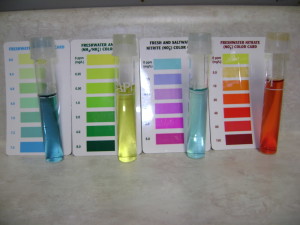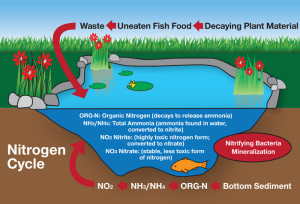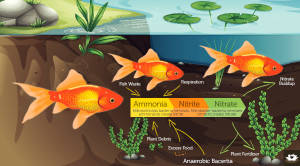HELP! Why are there red marks on my fish?!?!? I tested my water but what does it mean when my water test kit produces blue purple green yellow and red water viles?! Take a step back. Relax, and get ready to learn what it all means and how to react when necessary.
Ammonia levels, nutrients, oxygen, and alkalinity – the list can baffle you whether you are new to ponds, or if you have been a long time pond owner. Everyone tells you something different. Some say your pond will be okay if your pH is between 7.0 and 8.5 … some say between 6.8 and 8.0 is the optimum level for your pond. It is confusing to anyone without a degree in chemistry. Who’s right and who’s wrong? What do you really need to watch when it comes to protecting the plants and aquatic creatures in your pond?
pH and Alkalinity
Let’s take a moment right here and now to go back to high school chemistry and review a few things about pH levels. First of all, what are they? Well, pH (presence of hydrogen) is a measure of the concentration of hydrogen ions in a solution. And if you jog your brain a bit, you may remember that the scale ranges from 0 to 14, where 7 is neutral. Values less than 7 are considered acidic, and values greater than 7 are basic or alkaline. On this inverted scale model, there’s a 10-fold increase between each number on the scale, meaning that a pH of 4 is 10 times as acidic as a pH of 5.
According to the environmental protection agency, a pH level ranging between 6.0 and 8.5 is a good profile for any natural stream, yet time and time again, you’ll see people debating levels. And each time it’s different. Koi experts believe that for their fish to thrive, pH levels should not be lower than 7.0 and should remain fairly neutral. The truth is that if you are merely raising Koi as pets, your best bet is to watch their behavior to see if conditions are suitable for them. Ideal conditions for ponds range from 7.5 to 8.5, below 6.5 can be too acidic for Koi.
Things Change
It’s important to remember that pH levels are constantly changing. They can vary significantly over a 24-hour period due to respiration and photosynthesis of the plants in the pond. So, what does that all mean? Well, in the case of respiration, the resulting carbon dioxide combines with water to form carbonic acid, which lowers the water pH. Algae utilize carbon dioxide and increase the pH during daylight hours. At night, photosynthesis stops and pH levels decrease. So, it is important to remember that taking a reading in the morning and a reading in the afternoon are two very separate things, so don’t get excited if the numbers vary. Aerating the pond at night can help stabilize the pH and increase dissolved oxygen levels.
Which Brings Us to Ammonia
According to Dr. Eric Johnson, ammonia is the No. 1 killer of fish in a new pond. “Ammonia is a big problem in new systems because the bacteria that would naturally convert ammonia are not established,” Dr. Johnson says. “As well, even in established systems, ammonia may accumulate in springtime when the water is cold but fish are eating, because filter bacteria have not emerged usefully from hibernation.”
So, how do you know that there are high amounts of ammonia in your system? “Ammonia accumulations cause reddening of the skin and disability of the gills by its direct caustic effect on these surfaces,” according to Dr. Johnson. “Fish suffering in water with high ammonia accumulations will isolate themselves, lie on the bottom, clamp their fins, secrete excess slime, and are much more susceptible to parasitic and bacterial infection.”
Ammonia is less toxic at a pH level below 7.4, but that doesn’t mean you have to worry. Ammonia doesn’t start to get too toxic until you reach pH levels over 8.0, and it also depends on the rest of the elements in your system.
Oxygen Levels
Just because there’s oxygen throughout our atmosphere doesn’t necessarily mean that there is enough to sustain life in your pond at all times. While fish can survive without food for a short period of time, oxygen cannot be compromised – even for a few minutes. There are two times, if you aren’t careful, when oxygen may be scarce for your fish … winter and summer.
In the warmer months, your pond may be the most deficient in oxygen in the early morning hours. This is because of plant photosynthesis. During the daylight hours, plants give off oxygen, and at nighttime the fish absorb that oxygen. So in the early morning hours, the oxygen is at its lowest. If you have a pump continuously re-circulating the water in your pond, however, this will not be a problem because your water will be constantly oxygenated.
In the wintertime, many pond owners choose to shut down their pond’s circulation system – the very circulation system that helps oxygenates the water. Also, when ice forms over the surface of the pond, a hole must be kept open allowing built up gasses to escape. To replicate the oxygenation and keep a hole open in the ice, a supplemental pump or aeration system should be set inside the pond, bubbling near the surface of the water.
A heater or deicer can also be used to keep a hole open in the ice, but never without the re-circulating or air pump. Deicers keep a hole open in the ice by heating the area around it when the water reaches a pre-set temperature. Remember, the heater does not oxygenate the water. In fact, in the process of heating the water, it actually uses up oxygen.
Regardless of the season, the best solution for keeping oxygen available in your pond is to have a continuously operating water pump and a sufficient filtration system, that keeps the water moving. Having the constant water flow and movement introduces more oxygen into the water.
Nutrient Levels
Nutrient levels are very important when it comes to your pond. They have a profound effect on your water clarity and how much algae you may encounter in your pond during certain weather changes. After all, nutrients are what algae feeds on in your pond, and if there are high amounts of nutrients, you’re going to have more algae. That’s where the bacteria come into play. By putting beneficial bacteria into your pond and allowing it to establish itself in the system, you have something that competes with the algae for the nutrients.
So, how do you get higher nutrient levels? Well, allowing fertilizer from the grass to run off into your pond can produce an algae bloom almost instantly. And, have you ever put fertilizer tabs into your plant pocket and found a patch of string algae floating near the area soon after? That could be because some nutrients being released from the soil get into the water. That doesn’t mean that you should stop fertilizing your plants though … just remember that a little string algae is no match for bacteria and that the end result – beautiful flowers and plants – is worth it.
Mulch that gets accidentally kicked into your pond, along with decaying aquatic plant material, and other organic matter that finds its way into your pond will also produce a spike in the nutrient level. You might also want to pay close attention to how much you feed your fish – un-eaten food can also contribute to excess nutrients in the pond water.
Aquatic Nutrition
Beyond pH, there are other contributors to water quality that must be considered right up front, namely, the macronutrients and micronutrients that help sustain life in aquatic systems. In all, 17 of these essential ingredients — three macronutrients and 14 micronutrients — need to be included in ponds and streams.
The macronutrients are what we find in commercial fertilizer mixes. When you see a fertilizer that says 20-10-20, for example, these numbers refer to the percentage (by volume) of nitrogen (N), phosphorous (P), and potassium (K) in the mix. These are the nutrients required in the largest quantities for proper plant growth.
Nitrogen: In a pond, ammonia and nitrate are the most common forms of available nitrogen. High levels of either of those substances are good for plants (especially algae) but are toxic to most fish, so it’s best if they are undetectable or held at very low levels. (2nd and 4th viles in the image above)
Phosphorus: Again, in a pond situation it is best to have low or non-existent levels of phosphorus, which appears in the water in the form of phosphates. Although in the case of a pond, these substances are not problematic for fish, they do invite prolific algae growth and therefore should be held at minimal levels.
Potassium: It’s rare to find high levels of potassium in pond ecosystems, but it wouldn’t be a problem in any event, because potassium is a key to both plant and fish metabolisms.
The other category you need to consider features the micronutrients. Fourteen of them are required for life: boron (B), carbon (C), calcium (Ca), chlorine (Cl), copper (Cu), iron (Fe), hydrogen (H), magnesium (Mg), manganese (Mn), molybdenum (Mo), nickel (Ni), oxygen (O), sodium (Na), sulfur (S) and zinc (Z). Each is required in different ratios for different members of a pond-based ecosystem, and each plays a highly specialized role on the cellular level for all forms of life.
A well-designed system will often produce water that is balanced in terms of pH and nutrient content. When algae blooms or other water-quality issues arise, don’t hesitate to seek help in determining treatment regimens that can correct the situation. A great start is the use of a Beneficial Bacteria to utilize the nutrients in the pond water that are feeding the algae cycle and zapping the oxygen from the water.
Consistency Makes Sense
The bottom line, when it comes to keeping your pond healthy and providing your aquatic life with the best possible conditions, is consistency. Any kind of dramatic change in your pond’s water is shocking to the aquatic life, but if changes are made gradually, everything should be okay. Another important thing to remember is that if nothing is wrong in your pond, don’t try to fix it. If your fish are exhibiting normal behavior, don’t do anything to change the pond’s environment … it’s just not logical.
“If everything seems to balance out in your pond, and your plants and animals are healthy, there’s no reason to run out to buy a pH testing kit,” Alcala said. “You can’t enjoy your pond if you are constantly worried about your water. Just wait for the signs before you act on anything.”
A Frog’s Dream Aquatic Services is offering this blog as a personal information source to our website visitors. Pond services are performed in Morris County New Jersey (NJ) Hunterdon County New Jersey (NJ) Somerset County (NJ) and Warren County (NJ). Waterfall ponds, Streams, and Fountains are all in our wheelhouse of talent. Explore our website for more ideas. Like our Facebook page for daily inspiration. Receive our newsletter for monthly tips and a coupon or two.



